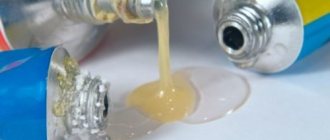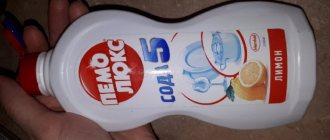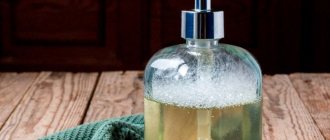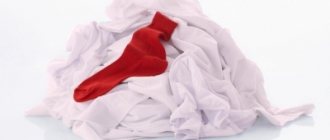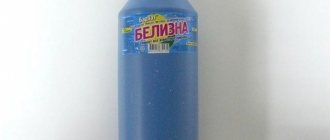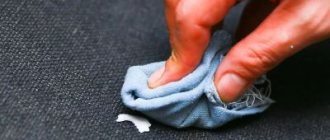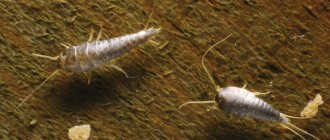How to choose a method for removing old stains from your favorite things
How to remove an old stain? This question arises every time when you really don’t want to say goodbye to a good thing because of a small stain. But wearing something with a stain is not an option. Old stains are more difficult to remove than fresh ones.
However, experienced housewives know effective recipes and can decisively remove even the oldest stains. Let's take their experience into account. We tried to collect useful recipes for removing old stains of various origins from clothes and home textiles. To better choose a method for removing an old stain, it is advisable to know what substance caused the stain. Old stains of grease, oil, blood, and sweat are removed in different ways.
When removing old stains, it is important not to spoil the item with the stain remover itself or a homemade cleaning agent. On colored fabrics, after removing the stain, white spots may remain that cannot be removed. Therefore, you need to test the stain remover on a small piece of fabric or on the inside of a lapel in a small area. After this, if the fabric is not damaged, you can safely remove the old stain.
For particularly stubborn stains, use more aggressive agents
Acetone, trichlorethylene, gasoline dissolve the resin. Benzene, toluene, acetone, turpentine get rid of contaminants containing oil and grease. Moisten a cotton swab with liquid and wipe the stain thoroughly.
Organic solvents often leave a so-called halo on fabric. In order to avoid its appearance, place several layers of cotton wool or gauze under the place on the clothing where the contamination is located.
An important condition for completely removing stains is recognizing the substances of which they are composed. It is also necessary to know what material the contaminated item is made of. It is advisable to first test the selected product on the inner seam or hem of the garment. We must act with extreme caution. If the fabrics are delicate, then it is better to entrust the fight against stubborn stains to professionals.
How to remove an old stain from butter or vegetable oil?
An interesting recipe for removing greasy stains with a mixture of turpentine and ammonia:
- first rub a small piece of laundry soap on a fine grater;
- mix turpentine and ammonia in a small container in a ratio of 2:1;
- mix with soap and apply to the old oil stain;
- After fifteen minutes, wash by hand, first in cool and then in warm water.
In order not to waste time rubbing soap, you can instead take a little natural soap powder Chistown or Belive.
Read more recipes for removing old grease stains in our article “How to remove grease stains from clothes.”
FABRIC COMPOSITION MATTERS
Incorrect processing and non-compliance with temperature conditions can damage the fabric more than the stain itself, so always read the care label for your product. If there is no label, use these general guidelines.
1. Shirts, which are predominantly cotton, are considered heat-resistant and can be washed in a washing machine. For pre-treatment, you can use mild acids, such as lemon juice or vinegar.
2. Synthetic fabrics are more tolerant of mechanical stress - they will withstand washing, but at the same time they are more sensitive to bleaching agents. Here it is safer to use regular washing powder to get rid of the stain.
How to remove old stains from white things?
On white things, stains are most noticeable. You can remove an old stain from a white cotton item with a ready-made stain remover. It is better to use oxygen stain removers than chlorine-based bleaches. They are not harmful to health and do not spoil things.
Belive Eco eco-friendly stain remover removes stains: oil, mold, coffee, grass, iodine, wine, greens, juices, resins, blood. Can be used both for pre-soaking and for washing together with laundry detergent or Belive washing gels for maximum stain removal.
Other ways to remove old stains from white:
- rub the dirty stain with a cloth soaked in vinegar or citric acid;
- lipstick stains are cleaned with a cotton swab and alcohol;
- Sprinkle the stain with baking soda, and then pour a solution of food-grade citric acid on top.
How to remove old sweat stains, read the article “How to remove yellow sweat stains from white things.”
LiveInternetLiveInternet
Difficult to remove stains from grass, greenery or resin threaten to ruin your favorite trousers or blouses forever.
A rating of the most insidious stains and effective ways to combat them has been compiled.
Blood.
If you stain your clothes with blood, do not rush to throw the item away. The difficulty of removing a stain depends on how long it was on the clothing, the fabric and whether you tried to remove the stain before? For example, if you have already tried to wash off the stain with hot water, you can say goodbye to the item. An old stain will be very difficult to remove, and on some types of fabrics it will remain forever.
✔ A small fresh stain can be washed off without much effort. You just need to place it under running cold water . If after this procedure the stain is not completely removed, rub it with laundry soap and leave for a few minutes, then rub well and, again, rinse under running cold water. ✔
If you want to wash the blood in the washing machine
, you can use stain removers that are applied to the stain itself and added to the water during washing. The water temperature should be minimal. Blood coagulates at a temperature of just over forty degrees, and this is what we should proceed from when setting the washing mode. There is only one way to remove clotted blood from clothing - by placing a decorative patch in place of the stain. You can try to remove such a stain with hydrogen peroxide , but this drug will most likely ruin the pattern on the fabric. If the fabric is delicate, the peroxide may burn through it. ✔
How to remove blood if the stain is dry?
Perhaps a saline solution will cope with it. To prepare it, take a tablespoon of salt per liter of cold water . The item from which the stain needs to be removed is soaked in this solution. After soaking, it is washed in slightly warm water using powder, soap or any other detergent. Sometimes the use of unusual products, such as dishwashing liquid, gives excellent results. ✔
remove old blood stains
from clothes using ammonia. For one liter of water, take one tablespoon of ammonia and soak the item with the stain in this solution, then carefully wipe the stain with the same or more concentrated solution using a cotton pad. If this does not help, and also if the stain remains on the upholstery of upholstered furniture, you can try starch paste .
You need to dilute the starch with water, apply it to the stain and let the paste dry. Then you just need to remove the crust from the starch with a clothes brush. Unfortunately, not all stains can be removed, so try not to put off washing until better times. It is better to spend a few minutes and try to clean the blood right away than to waste hours later trying unsuccessfully.
Grass.
Playing outdoors can often take a toll on light-colored T-shirts, light pants or dresses. To prevent grass from becoming the reason for parting with your favorite thing, use the following tips.
✔
To remove
stains from cotton , soak it in lemon juice and salt and then dry it in the sun. ✔
Silk
will be saved by a few drops of ammonia or hydrogen peroxide .
✔
The easiest way to remove grass stains is
a solution of table salt (one tablespoon of salt per glass of water). Clothes with a stain are first soaked in this solution and then washed in warm water. This solution can also be used to remove stains from ink, wine, grease and sweat. ✔
from cotton fabric
using a three percent solution of hydrogen peroxide or a solution of bleach (one teaspoon per glass of water). However, this recipe can only be used on white fabric, as hydrogen peroxide and bleach will eat away the color. ✔
You can remove grass and flower stains using
denatured alcohol. It is necessary to wipe the area with the stain with a cotton swab dipped in alcohol until it completely disappears.
Then you need to wash the fabric in hot water with powder or soap. Zelenka.
Some of the most difficult stains to remove appear after using brilliant green. Experienced housewives know very well how to get rid of green stains on leather, furniture upholstery, clothing and other surfaces for which the cheerful green color does not suit them at all.
✔
The simplest and most effective way to get rid of stains from this drug is to use any alcohol solution.
Medical or salicylic alcohol, or even vodka, are perfect for this This method is considered almost universal and is suitable for processing many surfaces. By the way, to make the alcohol work better, you can add a little lemon juice to it . So, apply rubbing alcohol to the contaminated area with a cotton swab or a clean white cloth, wait a minute and rinse with warm water. Repeat the procedure if necessary.
✔
If the item is white, then feel free to use
hydrogen peroxide. ✔
For colored clothes,
a 10% ammonia solution or ascorbic acid is suitable. ✔
You can also try to remove the green stain with
Domestos (in a yellow bottle with lemon and a bleaching effect) - pour it on the stain and wait 20 minutes, then wash as usual.
Iodine. A fairly common medicine, iodine, can cause a lot of problems and ruin a good thing if it gets on the fabric. It is not always possible to carefully apply iodine to the affected area and often you have to remove stains from your favorite blouse or jeans.
It is possible to remove such stains only when these stains are very fresh , otherwise it is usually impossible.
✔
So, in order to remove an iodine stain, soak it under cold water, and then rub it
with starch until it disappears completely, not forgetting to wet the stain with cold water from time to time.
✔
Starch can be replaced
with fresh potatoes. Milk or ammonia can also help , but rubbing will take longer.
✔
To get rid of iodine stains, you can turn to the good old advice of our grandmothers.
An old, proven way to remove iodine stains is to dilute a spoonful of ordinary ammonia in two glasses of purified water and wipe the stain with this solution.
After applying the solution to the stain, leave it for 15 minutes, and then thoroughly wash the product in warm, soapy water. ✔
Some people, instead of ammonia, use
hyposulfite (sodium thiosulfate) , which can be found in any photography studio, to remove iodine stains.
Potassium permanganate. Potassium permanganate is a strong antiseptic and an equally strong dye that can leave permanent stains on clothes and furniture. And if you can’t wash off potassium permanganate with washing powder or bleach, acids will help remove stains from potassium permanganate. Potassium permanganate is a chemical substance, which means that only chemistry can neutralize it.
✔
Some fabrics, for example wool, are not recommended to be exposed to acids.
Potassium permanganate stains from delicate fabrics are washed off with yogurt or whey. To do this, you need to soak the stained area in yogurt or whey for 3-4 hours, you can leave it overnight, and then wash the product in cool water.
✔
, a weak solution of hydrogen peroxide
is also used ✔
Stains from potassium permanganate
on white fabric must be treated with a solution of oxalic acid (1 teaspoon per 100 ml of water).
Apply the resulting solution to the stain and wait a few minutes. After this, rinse the product first in hot and then in warm water. ✔ Citric acid can cope with fresh and old stains from potassium permanganate. It is sold in powder form in grocery stores in 10-20 gram bags. Lightly moisten the stain with warm water and sprinkle with citric acid powder. Leave to soak for 10-15 minutes, then rinse with warm water. If necessary, the procedure is repeated.
✔ Sodium hyposulfite can be purchased at a pharmacy. We need a 10% solution, apply it to the stain and leave for 10 minutes, then wash the clothes in warm water.
✔ Wipe dirty hands with a piece of lemon or moisten with a solution of citric acid and do not wash off your hands for about five minutes. The potassium permanganate stain should disappear during this time.
✔
Vinegar or hydrogen peroxide will have exactly the same effect - your hands will become clean.
Band-Aid.
Many housewives have more than once encountered stains from adhesive plaster. In this situation, it seems that the item is hopelessly damaged. But everything can be fixed.
✔
To harden the substance, apply
ice . Then remove the pieces with a knife, then place the cloth on blotting paper and wipe with a swab dipped in gasoline, alcohol or acetone . And only then can you start washing.
✔
Traces of adhesive tape
on the skin can be removed with alcohol, vodka, cologne, and greasy cream .
Dampen a cotton pad and rub the desired area of skin. Any of these options will do, choose for yourself. Rust.
Rust stains can appear on fabric from rusty water, from contact with rusty metal, or from a coin forgotten in a pocket. Don’t be upset and don’t rush to get rid of your favorite shirt or trousers! You will be surprised how many simple and accessible ways there are to remove rust from fabric.
✔
Rust stains
on wool or silk can be easily removed using a solution of water and ammonia (6:1).
✔
cotton products, it is best to use lemon juice . FRESHLY SQUEEZED lemon juice. Mix one part fresh lemon juice and one part cold water in a cup. Immerse a piece of cloth with a rust stain in the solution for 30 minutes. Remove the fabric from the solution, wring it out and check to see if the stain remains. Never wash this type of stain with hot water, only cold. If the stain has not yet come off, let the item sit in the solution for another 15 minutes.
If the stain remains, rinse thoroughly in cold water and then soak the area in undiluted liquid laundry detergent. Rub the fabric as vigorously as possible. After that, simply wash the clothing according to the instructions on the label. ✔
The next method also involves
lemon juice. But first, the stained fabric must be placed on several layers of paper towels with the stain facing up. It is they who will absorb unpleasant rust in the future. Sprinkle salt .
Cut the lemon in half and rub the pulp firmly against a cloth. Cover with several more layers of towels and place in the sun to dry for at least two hours. The rust stain will gradually disappear. Wash the item as usual. ✔
There is another quick way.
Stretch a cloth with rust stains over a pan of boiling water and sprinkle citric acid or lemon juice . Leave the cloth in this position over boiling water for five minutes, then rinse. Repeat the procedure if necessary.
✔
A rust stain can be removed by immersing the contaminated area for 3–5 minutes in
a solution of acetic acid (at the rate of 2 tablespoons of vinegar per glass of water), heated to a temperature of 80–90 degrees.
To do this, it is recommended to use enamel cookware that is not damaged. Then the fabric is washed with warm water with the addition of ammonia (at the rate of 1 tablespoon of 10% alcohol per 1 liter of water). ✔
Our grandmothers knew this method.
Mix a thick paste of vinegar and salt .
Apply the paste to the stain. Leave on for about 30 minutes and rinse with warm water. The stain was gone. If all these methods do not help, industrial rust removal methods remain. You can simply go to a dry cleaner, or you can purchase household cleaning products specifically designed for these purposes. Strictly follow the instructions on the package and use rust removal chemicals only in a well-ventilated area. Rinse items immediately after chemical treatment, otherwise the clothes may be seriously damaged. One last thing: try not to use bleach as a clothes cleaner for rust stains . Bleach may not do the job and may simply turn the stain from brown to yellow.
Resin.
Those who like to sit under trees will simply need the following advice.
✔
A fresh resin stain is washed off with gasoline or trichloroethylene . ✔
A dried stain
can be softened with vegetable or butter and then washed.
✔
An effective way is to use a solvent.
It must be said that depending on the fabric, you can use different solvents. If the resin is of plant origin , then turpentine, gasoline, aviation kerosene or nail polish remover will do. If the stain is made of synthetic resins , then it is better to use toluene or a toluene-based solvent.
Moisten a soft, light-colored swab with alcohol (or another solvent) and soak the cloth around the stain. This is to ensure that the stain does not start to spread as you remove the resin. Now feel free to clean your stain.
Lipstick.
If you find lipstick on your clothes, then there is no need to panic.
✔
Baking soda and lemon will help you remove lipstick stains Pour a small amount of baking soda into a bowl and squeeze half a small lemon into it. Combine everything into a homogeneous mass to make a paste, and apply it to the dirty area. Let the paste dry, then clean everything with a brush and wash the area in warm water - the stain will disappear.
✔
Ammonia
will also help you remove lipstick from fabric. Take a cotton pad, soak it in ammonia and wipe the stained area. The stain will disappear, but the smell is more difficult. To remove the strong odor, wash with detergent and then rinse thoroughly. ✔
Lipstick stains from fabrics that
cannot be washed can be removed with turpentine. To do this, clean the stained area with a brush and remove dust. Soak a cotton pad or swab in turpentine and wet the lipstick stain - (turpentine is an essential oil based on pine extract, which is used as a solvent for fat, oil, resin). Then place dry wipes on the bottom and top of the stains and iron them. ✔
If lipstick needs to be removed from fabric that
needs to be washed , sprinkle the lipstick stain with borax (sodium borate is a natural detergent) and pour 3% hydrogen peroxide on top. After the stain disappears, rinse the area with water.
To the hostesses:
Removing stains on fabrics using improvised means
Removing paraffin and wax stains
How to wash kitchen towels
Secrets of proper soaking of laundry
How to remove old stains from colored fabric?
Old stains from colored fabric must be removed more carefully so that no light stains remain. Therefore, when removing old stains from colored items, it is better not to use hydrogen peroxide and acetone. Also, do not use chlorine bleach.
Belive Eco stain remover can be used to remove stains from colored items. The oxygen bleach contained in the stain remover is safe for health, environmentally friendly, and does not damage fabrics when washed or soaked.
Homemade recipes for removing old stains from colored items:
- rub the stain with ammonia diluted with water;
- Rub the stain with a mixture of egg white and glycerin in equal proportions.
Now you know how to remove old stains from white and colored things.
Two most important rules
Before you wash stubborn stains, you need to pay attention to several important nuances. Firstly, no product is universal, that is, it is impossible, for example, to remove stains on silk and burlap using the same chemical. Secondly, it is necessary to establish the nature of the pollution in order to choose the optimal method to combat it.
What does this look like in practice?
Features of the material
It is imperative to understand what material you are dealing with and understand the composition of the fibers. All this information should be indicated on the label; there are also tips on washing (hand/machine; maximum permissible temperature) and care (is ironing allowed, is it permissible to use bleaches).
The most difficult thing to deal with is traces of old dirt on such delicate and “complex” materials as silk, velvet, gauze, chiffon, jacquard, nylon, viscose, etc. They absolutely do not tolerate chlorine bleaches, hot water and intensive washing. They also ambiguously apply to some folk remedies for removing stains.
How do you know that the product you choose (homemade or store-bought) will not harm the fabric? Before soaking the entire item in it, you should test it on an inconspicuous area (inner seam) and wait for the fabric to react. If the material does not deform and the color does not change, then it can be used.
In addition, it is also important that colored or white clothes need to be cleaned. For example, hydrogen peroxide is great for white clothes, but this chemical compound can ruin a bright dress. And on the contrary, some products work well in the case of colored clothes, but snow-white linen turns yellow or darkens.
Origin of pollution
Another point to consider when dealing with stains is the nature of the stain. The problem will be solved if the stain remover can enter into a chemical reaction with dirty marks. For example, fuel oil is removed from clothing using purified gasoline, and blood is removed using ammonia.
But let's find out what types of pollution are considered difficult to remove. This group includes traces from:
- blood;
- green grass;
- sweat discharge (especially if the item is not washed immediately);
- paints;
- fuel oil (bitumen, machine oil);
- some food products;
- ink;
- brilliant green, methylene blue;
- rust.
Old and complex food stains are conventionally divided into several subgroups. And each of them will have to be fought using special means.
Photo: https://pixabay.com/photos/red-wine-spill-spot-glass-red-505296/
What products leave stubborn stains on clothes? This:
- fat and oils;
- coffee;
- red wine;
- some fruits and vegetables (blueberries, currants, beets, etc.);
- jam and jam from some fruits;
- ketchup;
- tomato paste;
- juices from dark berries and fruits.
In addition, the “age” of the contamination is also important. The faster you start fighting stains, the easier it will be to get rid of them. And vice versa: old traces of almost any origin are much more difficult to remove. You will have to resort to aggressive means, and this increases the risk of ruining the item.

